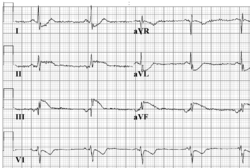Ectopic Complexes: Difference between revisions
m (New page: =Ectopic beats= The pacemakercells in the sinusnode are not the only cells in the heart that can depolarize spontaneously. Actually all cardiomyoctyes have this capacity. The only reason w...) |
(No difference)
|
Revision as of 15:11, 23 July 2007
Ectopic beats
The pacemakercells in the sinusnode are not the only cells in the heart that can depolarize spontaneously. Actually all cardiomyoctyes have this capacity. The only reason why the sinusnode 'rules' is that it is the fastest pacemaker of the heart. From sinusnode to ventricle all healthy cardiomyocytes can function as a ectopic pacemaker. Ectopic pacemaker activity can originate from the atria (60-80 bpm), AV-node (40-60 bpm) and the ventricles (20-40 bpm). So, as the sinus rate drops (e.g. during atrial infarction), other cells can take over. The configuration of ectopic beats or extrasystoles, as seen on the ECG, reveals its origin, whether they are atrial, nodal or ventrical.
Ectopic pacemakers
- Atrial ectopic pacemaker: frequency 50-60bpm
- Nodal ectopic pacemaker frequency 50bpm
- Ventricular ectopic pacemaker frequency 30-40bpm
Atrial rhythm
Atrial rhythm resembles sinusrhythm, but origins from a different atrial focus. It can be recognised by the abnormal configuration of the p-wave. Often the p-wave is negative in AVF, as is seen in the example.
Wandering Pacemaker
When several pacemakers are competing, p-waves with different origins and thus configurations occur. The rhythm is slightly different from beat to beat.
note If the heart rate increases to above 100bpm, it is called Multifocal Atrial Tachycardia. Possible causes are hypoxia, COPD and medication such as digoxin.
Premature atrial complex / atrial extrasystole
Premature atrial complexes origin from an ectopic pacing region in the atria. The result is a p-wave with often a different morphology as the preceding ones.
AV-nodal complexes
Originate from the AV node. The AV node fires before the sinusnode. The ECG shows a QRS complex with a comparable morphology as during sinus rhythm as these extra beats are conducted further through the normal conduction system. When the extra follows very soon after the earlier one, aberrant conduction can occur. The extra beat does not have a p-wave in front of it. Sometimes an inverted p-wave can be seen in or at the end of the QRS complex.
Ventricular premature beat (VPB) / Ventricular extrasystole (VES)
A VPB is an ectopic beat that origins from the ventricles. VPBs are hardly conducted by the specialised conduction system and therefore are broad. The QRS width is at least > 0.12 seconds, but often very broad at around 0.16-0.20 seconds.
Causes: e.g. ischemia, hypoxia, old scar tissue, idiopathic. 50% of healthy men have sporadic VPBs. The origin of the VPB can be derived from its form. A LBTB-configured VPB originates in the right ventricle. A RBTB-configured VPB comes from the left ventricle. The QRS duration of a VPB is > 0.12 seconds and can be as wide as 0.16-0.20 seconds.
A sequence of three or more extrasystoles is called a non-sustained ventricular tachycardia.
If more than one VPB is present on the ECG, they can be:
- monomorphic: all VPBs have the same configuration and thus have a mutual focus of origin.
- multiformic: the complexes have different configurations.
Bigemini
Every sinus beat is followed by a ventricular extrasystole.
Trigemini
Every second sinus beat is follow by a ventricular extrasystole.





